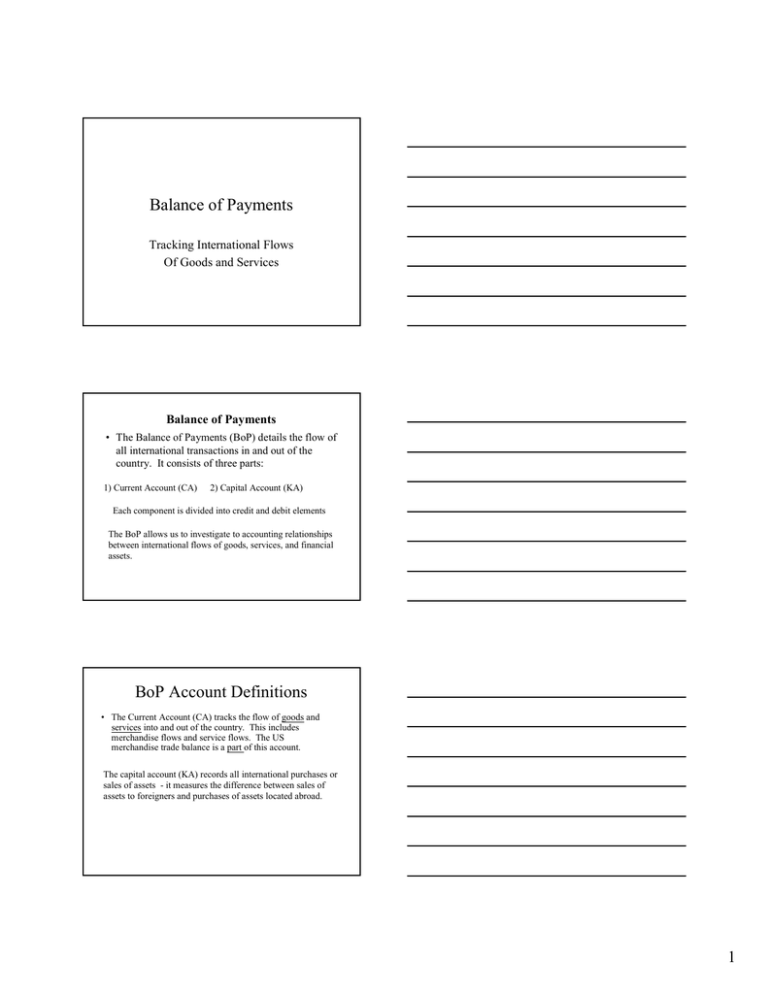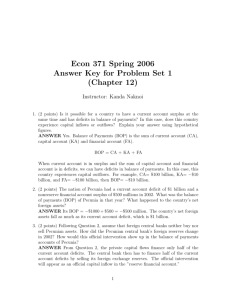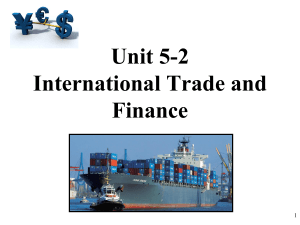Balance of Payments Tracking International Flows Of Goods and Services
advertisement

Balance of Payments Tracking International Flows Of Goods and Services Balance of Payments • The Balance of Payments (BoP) details the flow of all international transactions in and out of the country. It consists of three parts: 1) Current Account (CA) 2) Capital Account (KA) Each component is divided into credit and debit elements The BoP allows us to investigate to accounting relationships between international flows of goods, services, and financial assets. BoP Account Definitions • The Current Account (CA) tracks the flow of goods and services into and out of the country. This includes merchandise flows and service flows. The US merchandise trade balance is a part of this account. The capital account (KA) records all international purchases or sales of assets - it measures the difference between sales of assets to foreigners and purchases of assets located abroad. 1 Merchandise Trade Balance • The Merchandise Trade Balance is the difference between a country’s exports and its imports – this measures only goods, and not service, flows. Exports are measured as a positive entry into the MTB since income is flowing into the country; imports are entered as a negative entry. A positive trade balance is a trade surplus, while a negative balance is a trade deficit. In 2000, the US purchased $1,222.7 billion in imported goods, while exporting $773.3 billion worth of goods – a trade balance of -$449.4 billion. However, the US had an $81.0 billion surplus in services in 2000. Current Account Balance • While the MTB is commonly cited, note that it ignores activity in the service sector. A more comprehensive view of the nation’s international activity is the current account (CA). The CA measures all non-capital transactions between a nation and the rest of the world. It has three main items: 1) The value of goods and services exported - the value of goods and services imported. 2) Income received from investments abroad – income paid to foreigners on their US investments 3) Any foreign aid received from foreigners – aid to foreigners CA Account Credits Debits Goods and Services Exports Imports Investment Income Income from foreign invest. Income paid to foreign investors Unilateral Transfers Transfers received from abroad Transfers to foreigners 2 Explaining the CA Account 1) Goods and services flows - measure the value of goods and service trade 2) Investment Income – Not the movements of investment capital, but the income received or paid on previous flows of capital (i.e. bond interest, stock dividends) 3) Unilateral Transfers – Payments made that are not an exchange for goods/services – e.g. foreign aid, remittances 2000 US CA Account (millions of dollars) Credit Debit 1. G/S flows Goods Exports 773,304 Service Exports 296,227 Goods Imports -1,222,772 Service Imports -215,239 2. Investment Income Invst. Income Received 345,394 Invst. Income Paid -359,050 3. Net Transfers -53,241 MTB -449,468 Goods/Services Balance -368,480 CA Balance -435,377 Why a Negative CA Balance? • What does a negative CA account indicate? Is it sustainable? A negative CA account is not a sign of US weakness – it can be Attributed to several global occurrences. 1) Rapid US economic growth in the 1990s - increased demand for imports. 2) Sluggish economic growth of US trading partners - lower income increases – lower demand for US exports. Therefore, could we look at the deficit as a sign of US economic strength? We must be careful with this statement as the deficit is not sustainable in the long run. 3 Current Account and the Macroeconomy • The BoP allows us to investigate the implications of a CA deficit and analyze the policies that could lead to a reduction of such an imbalance. • One such way to investigate these implications is to examine the link between the CA and GDP National Income and Product Accounts Recall these definitions 1) GDP = C+I+G+X-M 2) GNP = GDP + net foreign investment income + net transfers where • C = consumption expenditures • I = investment expenditures • G= government expenditures • X= exports • M= imports Thus, we can write GNP = C+I+G+CA This equation links GNP to its components of output (how we generate GNP) NIPA and the CA • We also know that we can use our income in one of three ways: consume (C), Save (S), or pay taxes (T). Therefore, we know that the uses of GNP can be shown by: GNP = C+S+T Thus, we can link GNP by its components and uses in the following formula: C+I+G+CA= C+S+T Rearranging this we find the accounting identity I+CA = S+ (T-G) 4 NIPA and CA (cont.) S+(T-G) = nations savings (Private savings + public savings) I+CA = Domestic Investment (I) + Foreign Investment (CA) Note, a positive CA account indicates an outflow of financial capital. The domestic economy is providing its savings to the rest of the world – enabling the country to sell more of its goods abroad. The financial capital outflow is seen as an investment because it Involves acquisition of assets that are expected to pay a future return. This can be seen as net foreign investment. Thus, in general, a country with a higher level of savings is able to sustain a higher level of foreign investment. Are CA deficits harmful? • Recall the identity: S+ (T-G) = I + CA • This identity does not indicate why an economy runs a surplus/deficit. CA deficits may be beneficial, since: 1) They may enable more investment than previously otherwise, since this is investment that is flowing in from abroad – leads to higher living standards? Higher productivity? 2) Investment inflows from abroad are an implicit “vote of confidence” by foreigners – a signal that investment is safe/secure CA deficits • CA deficits may be harmful, however, since Increased stock of foreign-owned assets in the country - could an economic downturn lead to capital flight? 5 The Capital Account (KA) • Two primary categories of the capital account: 1) Net changes in US-owned assets abroad 2) Net changes in foreign-owned assets in the US Assets can be stocks, bonds, government securities, and real assets such land, factories, businesses. Purchases of foreign assets (increases in capital outflows) are recorded as a debit on the BoP; Foreign purchases of domestic assets (increased capital inflow) are recorded as a credit in the BoP. The BoP and the KA • The Balance of Payments should balance; thus CA+ KA = 0 Thus, if we are running a CA surplus, we will have a KA deficit; a CA deficit implies a KA surplus A KA deficit indicates that the country is a net lender; A KA surplus indicates that the country is a net debtor What is the United States? Financing the CA deficit • A CA deficit implies a KA surplus – the country is a net debtor nation. How does the country finance its debt? Case Study: US 1970’s – debt was serviced by foreign official capital inflowsnet purchases of US government securities In the 1980’s and 1990’s – CA deficits have been financed by private capital flows (US bank lending, purchases of real assets, foreign direct investment in the US) 6 Statistical Discrepancy • While CA+KA=0 in theory, reality suggests that the numbers do not always equal. • The Statistical Discrepancy is the sum of CA+KA with the sign reversed • This exists because recordkeeping for the BoP is incomplete, especially on the financial side of international transactions • The Statistical Discrepancy is often relatively small 7





